IT Device Market Size
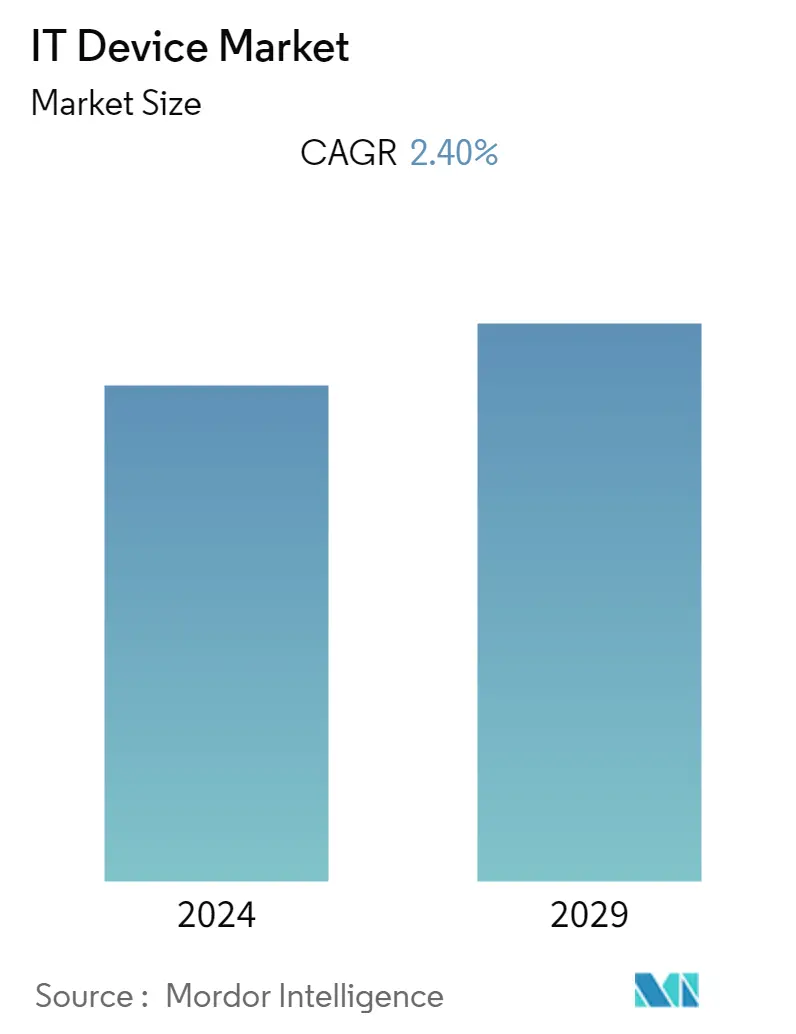
| Study Period | 2019 - 2029 |
| Base Year For Estimation | 2023 |
| Forecast Data Period | 2024 - 2029 |
| CAGR | 2.40 % |
| Largest Market | Asia-Pacific |
| Market Concentration | Low |
Major Players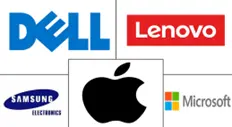
*Disclaimer: Major Players sorted in no particular order |
IT Device Market Analysis
The IT device market is expected to grow at a CAGR of 2.4% during the forecast period. The market is expected to witness growth in the forecast period owing to the higher demand for mobile devices. During the COVID-19 epidemic, there was an increase in demand for PCs due to businesses' and consumers' growing flexibility and mobility requirements.
- The demand for mobile phones has been growing over the past several years as consumer spending has increased globally. Notably, the smartphone demand has been continuously expanding in terms of models and market size. It was projected that 40% of people owned a smartphone last year. According to Ericsson, the number of smartphone subscribers globally has surpassed six billion and is projected to increase by several hundred million more over the next several years. China, India, and the United States are the top three nations with the most smartphone users.
- Notably, laptop sales are escalating in major countries, such as the United States and China. Major laptop manufacturers have reported an increase in sales of computers following the COVID-19 pandemic. Due to the continuous updates of graphics, connectivity, weight, and portability, the demand for the latest technology device is always anticipated.
- However, the higher demand for laptops has caused personal computer sales to be contracted across the globe. Also, after the pandemic, due to the work-from-home and social distancing norms, there was an upswing in demand for PCs. However, with everything back to normal, people have returned to their offices and institutions. Thus, the need for personal computers has slowed. Also, further contraction is expected in PC sales worldwide for the forecast period.
- China is leading the global IT device market, followed by the United States, Japan, and India. China had the highest revenue in the phone segment for the last year. At the beginning of this year, China had 1.63 billion mobile phone connections, according to data from GSMA Intelligence. During the second financial quarter of this year, Honor and Vivo held the highest smartphone market share.
- During the COVID-19 pandemic, the global demand for IT devices like PCs, laptop tablets, and phones grew. The surged demand mainly backed this growth for networking devices owing to social distancing and work-from-home regulations worldwide. However, the demand for personal computers fell with the gradual withdrawal of restrictions and the reopening of offices and institutions. Notably, the demand for mobile phones, especially smartphones, is expected to stabilize during the post-COVID-19 period.
IT Device Market Trends
This section covers the major market trends shaping the IT Device Market according to our research experts:
Robust Contribution from Mobile Segment
- In many densely populated nations, such as China and India, the smartphone penetration rate is still around 70%, giving the market for smartphones significant room for development. Despite stagnant unit sales over the past several years, the worldwide smartphone market's revenue has increased because the average selling price of smartphones has increased.
- The mobile phone market is vast and will likely keep expanding and influencing many more markets. The improvement of wireless connectivity makes it easier to integrate cutting-edge technologies like IoT, AI, AR, and cloud computing into mobile devices. Thereby, there is a rapid demand shift in the market for these IoT-enabled devices from traditional wireless phones.
- People worldwide now have access to connections on the back of a significant mobile network. According to a GSMA report, globally, there were 4.2 billion subscribers to mobile internet last year. This number is expected to grow to 5 billion by 2025. The increased demand for internet subscribers has escalated the market for smartphones across the globe.
- As per Mobile Economy's this year's report, the number of unique mobile subscribers as of last year was 5.3 billion, which is expected to grow to 5.7 billion by the end of 2025. Also, the global sim connection is expected to grow remarkably from 8.3 billion last year to 8.8 billion in 2025. Notably, the global smartphone penetration is anticipated to increase from 75% last year to 84% in 2025.
- The GSMA's report predicts that by 2025, there will be 2 billion 5G connections worldwide, surpassing the current level of 1 billion connections. In the smartphone industry, 5G has also become a significant player, and it is expected to change how people use their phones today. Over the past several quarters, the shipment of devices with 5G capabilities has grown significantly worldwide.
- According to GSMA, the mobile industry contributed USD 4.5 trillion to the global GDP last year, or 5% of the entire global GDP. According to the forecast, the mobile industry is expected to witness a contribution of USD 4.9 trillion by 2025.
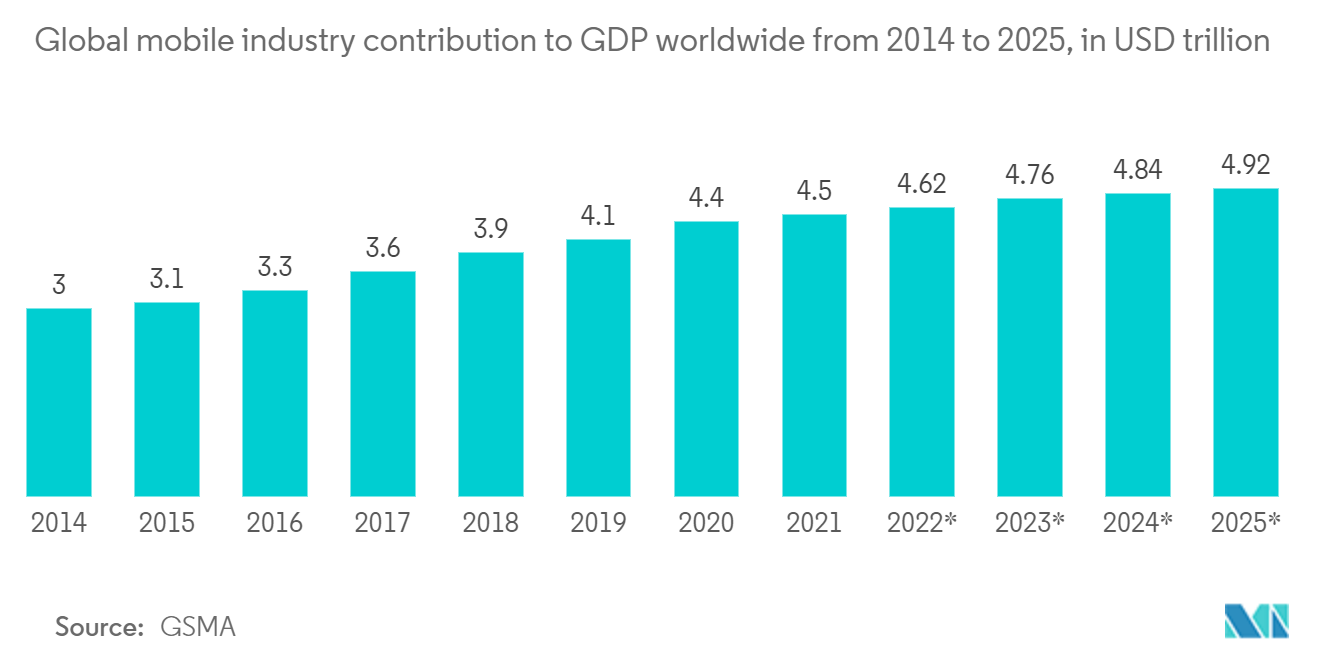
Asia-Pacific Holds a Significant Share
- Densely populated countries of the Asia-Pacific are expected to witness rising demand for IT devices during the forecast period. This growth is mainly attributable to the increasing levels of internet use, more disposable incomes, greater consumer awareness of the advent of cutting-edge technology, and, most importantly, the expanding population in this region. Such factors are driving the market's expansion.
- The Asia-Pacific region's economy continues to benefit significantly from the mobile ecosystem, which now accounts for 5% of the regional GDP and USD 770 billion in additional economic value. According to GSMA, the expected number of unique mobile subscribers in the Asia-Pacific would increase from 1.6 billion or 59% last year to 1.8 billion or 62% in 2025. Also, the number of mobile internet users in the region is anticipated to surge from 1.2 billion or 44% last year to 1.5 billion or 52% in 2025. From the upswing of mobile internet users, it can be forecasted that the demand for smartphones will be observed for the upcoming period.
- Additionally, as per the GSMA report, the smartphone adoption rate in the Asia-Pacific is expected to increase from 74% previous year to 84% in 2025. Also, from 2020 to 2025, there would be an expected addition of half a billion new mobile subscribers globally, which the Asia-Pacific alone would contribute to approximately 188 million additional subscribers. However, there is a substantial usage gap in the population's mobile internet connectivity in the region, which leaves scope for further growth in smartphone penetration.
- China is currently the No. 1 owner of the fastest supercomputers in the world for the eighth time since November 2017, owing to the inclusion of 186 Chinese supercomputers on the most recent list of the world's Top-500 supercomputers, which makes up about 40% of all those on the list. By 2025, the Chinese government may use up to 10 exascale supercomputers. Supercomputers have developed quickly in recent years due to the rising need for processing capacity.
- Encouragingly, through the projected period, countries like China and India are anticipated to propel market expansion on the back of increased government initiatives to enhance laptop manufacturing and lower import taxes on spare parts. Also, technological advancement and changing trends, the need for faster updates, and compatibility with emerging technologies are driving the laptop market in APAC.
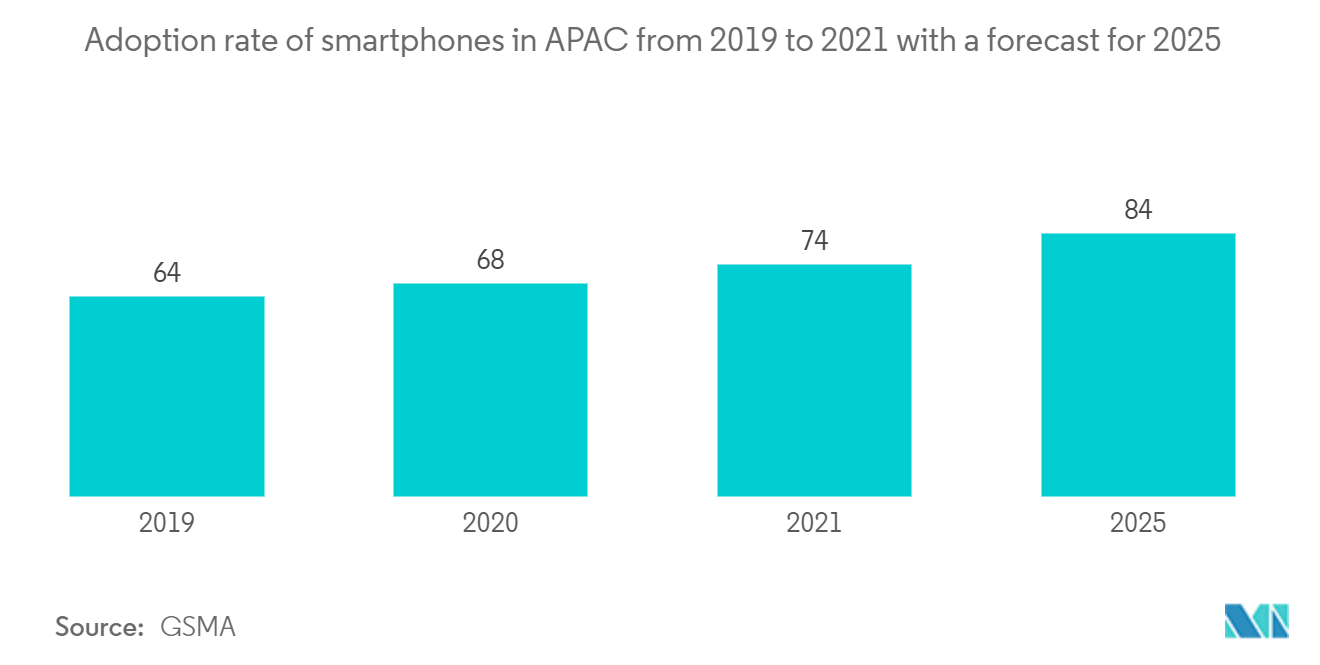
IT Device Industry Overview
The IT Device market is highly fragmented as it currently consists of many players. Several key players in the market are in constant efforts to bring advancements. A few prominent companies are entering into collaborations and expanding their global footprints in developing regions to consolidate their positions in the market. The major players in this market include Dell Inc., Lenovo Group Limited, Apple Inc., Samsung Electronics Co., Ltd, and Microsoft Corporation.
In November 2022, Microsoft launched new Surface devices that ushered in the next phase of computing for Windows PCs. With the introduction of the new Surface products, Microsoft's top features are combined on a single gadget, allowing all users to participate, be heard, seen, and creatively express themselves.
In October 2022, Samsung Electronics Co., Ltd, the market leader in advanced memory technology, confirmed that the most recent LPDDR5X DRAM, which boasts the best performance in the industry at 8.5 gigabits per second (Gbps), has been approved for usage on Snapdragon mobile platforms. Samsung surpassed the previous maximum speed of 7.5Gbps in March, reiterating its dominance in the memory industry.
IT Device Market Leaders
-
Lenovo Group Limited
-
Dell Inc.
-
Samsung Electronics Co., Ltd.
-
Apple Inc.
-
Microsoft Corporation
*Disclaimer: Major Players sorted in no particular order
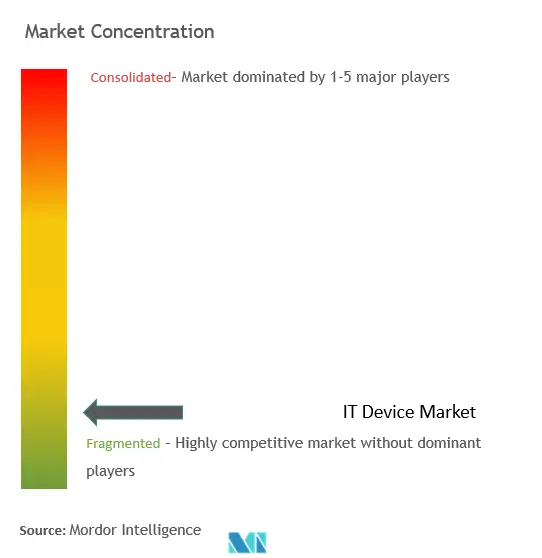
IT Device Market News
- September 2022: Apple, the leading telephone brand in the world, launched iPhone 14 and iPhone 14 Plus. Both devices include a potent new main camera with a significant improvement in low-light performance, improved connection with 5G and eSIM, and the phenomenal A15 Bionic performance, which contributes to even longer battery life. This, combined with iOS 16's close integration, makes iPhone more efficient than ever.
- September 2022: Lenovo released the ThinkPad X1 Fold and other goods at IFA 2022. With the new 16-inch ThinkPad X1 Fold, the second-generation follow-up to the original ThinkPad X1 Fold, Lenovo has added a new folding device to its ThinkPad family. The new ThinkPad Fold has a larger screen, Windows 11, mobile CPUs from Intel's 12th generation, and other improvements.
IT Device Market Report - Table of Contents
1. INTRODUCTION
- 1.1 Study Assumptions & Market Definition
- 1.2 Scope Of The Study
2. RESEARCH METHODOLOGY
3. EXECUTIVE SUMMARY
4. MARKET INSIGHTS
- 4.1 Market Overview
-
4.2 Industry Attractiveness - Porter's Five Force Analysis
- 4.2.1 Bargaining Power of Suppliers
- 4.2.2 Bargaining Power of Consumers
- 4.2.3 Threat of New Entrants
- 4.2.4 Threat of Substitute Products
- 4.2.5 Intensity of Competitive Rivalry
- 4.3 Assessment Of The Impact Of COVID-19 On The IT Device Industry
5. MARKET DYNAMICS
-
5.1 Market Drivers
- 5.1.1 Rising Demand for 5G Enabled Mobile Devices
- 5.1.2 Growing Mobile Broadband Penetration
- 5.1.3 Technology Advancement in the APAC Region
-
5.2 Market Restraints
- 5.2.1 Contracting Demand for Desktop Computers
6. MARKET SEGMENTATION
-
6.1 By Type
- 6.1.1 PC's
- 6.1.1.1 Laptops
- 6.1.1.2 Desktop PCs
- 6.1.1.3 Tablets
- 6.1.2 Phones
- 6.1.2.1 Landline Phones
- 6.1.2.2 Smartphones
- 6.1.2.3 Feature Phones
-
6.2 By Geography
- 6.2.1 North America
- 6.2.1.1 United States
- 6.2.1.2 Canada
- 6.2.2 Europe
- 6.2.2.1 Germany
- 6.2.2.2 United Kingdom
- 6.2.2.3 France
- 6.2.2.4 Italy
- 6.2.2.5 Spain
- 6.2.2.6 Rest of Europe
- 6.2.3 Asia-Pacific
- 6.2.3.1 Australia
- 6.2.3.2 China
- 6.2.3.3 India
- 6.2.3.4 Japan
- 6.2.3.5 Indonesia
- 6.2.3.6 Malaysia
- 6.2.3.7 South Korea
- 6.2.3.8 Rest of Asia-Pacific
- 6.2.4 Latin America
- 6.2.4.1 Brazil
- 6.2.4.2 Argentina
- 6.2.4.3 Mexico
- 6.2.4.4 Colombia
- 6.2.4.5 Rest of Latin America
- 6.2.5 Middle East and Africa
- 6.2.5.1 Saudi Arabia
- 6.2.5.2 United Arab Emirates
- 6.2.5.3 Qatar
- 6.2.5.4 Kuwait
- 6.2.5.5 South Africa
- 6.2.5.6 Egypt
- 6.2.5.7 Nigeria
- 6.2.5.8 Rest of Middle East and Africa
7. COMPETITIVE LANDSCAPE
-
7.1 Company Profiles
- 7.1.1 Lenovo Group Limited
- 7.1.2 Dell Inc.
- 7.1.3 Acer Inc.
- 7.1.4 ASUSTek Computer Inc.
- 7.1.5 Microsoft Corporation
- 7.1.6 Razer Inc.
- 7.1.7 Micro-Star International Co.
- 7.1.8 Toshiba Corporation
- 7.1.9 Samsung Electronics Co., Ltd
- 7.1.10 Apple Inc.
- 7.1.11 Honor Technology, Inc.
- 7.1.12 Xiaomi Corporation
- 7.1.13 Nokia Corp
- 7.1.14 LG Corporation
- 7.1.15 Vivo Communication Technology Co., Ltd
- 7.1.16 Realme Mobile Telecommunications Corp. Ltd
- *List Not Exhaustive
8. INVESTMENT ANALYSIS
9. FUTURE TRENDS
** Subject To AvailablityIT Device Industry Segmentation
The IT devices market segments comprise the critical IT and Telco equipment markets, including the segments of PCs and phones. Market values represent revenues paid to key vendors at the manufacturer price level directly or indirectly through distribution channels. The market revenues include spending by business-to-consumers (B2C), business-to-business (B2B) as well as business-to-governments (B2G).
IT Device Market is Segmented by Type (PCs and Phones) and Geography (North America, Europe, Asia-Pacific, Latin America, and Middle East and Africa). The market sizes and forecasts are provided in terms of value in USD million for all the above segments.
| By Type | PC's | Laptops |
| Desktop PCs | ||
| Tablets | ||
| By Type | Phones | Landline Phones |
| Smartphones | ||
| Feature Phones | ||
| By Geography | North America | United States |
| Canada | ||
| By Geography | Europe | Germany |
| United Kingdom | ||
| France | ||
| Italy | ||
| Spain | ||
| Rest of Europe | ||
| By Geography | Asia-Pacific | Australia |
| China | ||
| India | ||
| Japan | ||
| Indonesia | ||
| Malaysia | ||
| South Korea | ||
| Rest of Asia-Pacific | ||
| By Geography | Latin America | Brazil |
| Argentina | ||
| Mexico | ||
| Colombia | ||
| Rest of Latin America | ||
| By Geography | Middle East and Africa | Saudi Arabia |
| United Arab Emirates | ||
| Qatar | ||
| Kuwait | ||
| South Africa | ||
| Egypt | ||
| Nigeria | ||
| Rest of Middle East and Africa |
IT Device Market Research FAQs
What is the current IT Device Market size?
The IT Device Market is projected to register a CAGR of 2.40% during the forecast period (2024-2029)
Who are the key players in IT Device Market?
Lenovo Group Limited, Dell Inc. , Samsung Electronics Co., Ltd., Apple Inc. and Microsoft Corporation are the major companies operating in the IT Device Market.
Which region has the biggest share in IT Device Market?
In 2024, the Asia-Pacific accounts for the largest market share in IT Device Market.
What years does this IT Device Market cover?
The report covers the IT Device Market historical market size for years: 2019, 2020, 2021, 2022 and 2023. The report also forecasts the IT Device Market size for years: 2024, 2025, 2026, 2027, 2028 and 2029.
IT Device Industry Report
Statistics for the 2024 IT Device market share, size and revenue growth rate, created by Mordor Intelligence™ Industry Reports. IT Device analysis includes a market forecast outlook to 2029 and historical overview. Get a sample of this industry analysis as a free report PDF download.



